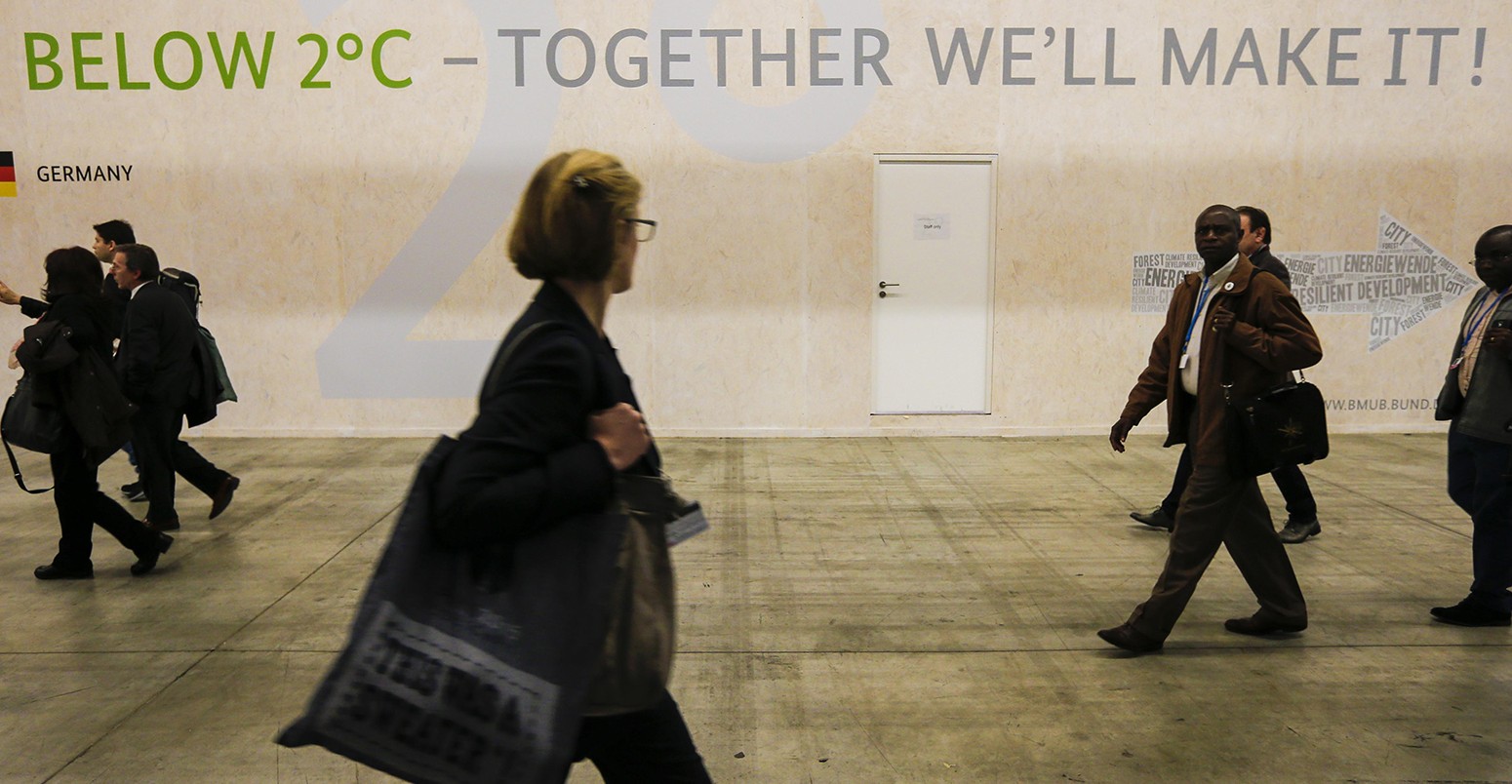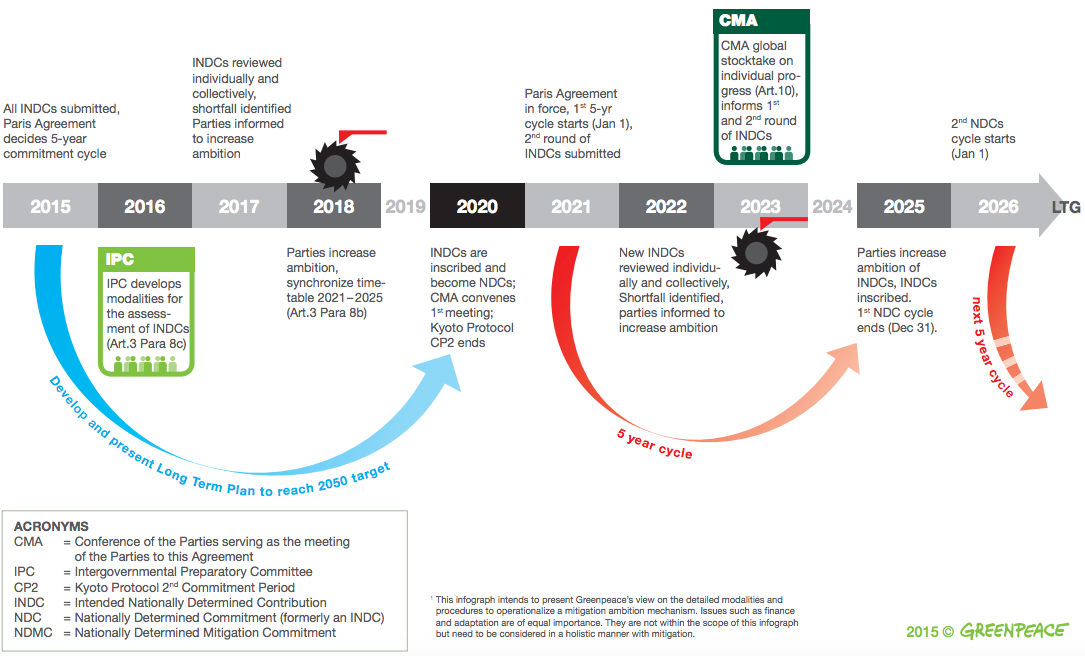
Explainer: the ‘ratchet mechanism’ within the Paris climate deal
Sophie Yeo
12.03.15Sophie Yeo
03.12.2015 | 12:38pmOne outcome of the Paris deal is already certain: it will not succeed in limiting temperatures to below 2C.
This has been repeated ad infinitum, by studies, by politicians and by observers.
Perhaps the most widely quoted figure for the impact of countries’ climate pledges on global temperature is the 2.7C rise calculated by Climate Action Tracker. The World Resources Institute has analysed the numerous other studies that come to similar conclusions.
The 2C limit has been enshrined as the aim of UN climate negotiations since 2010 — so if Paris has already failed to achieve it, why is it not already being labelled as a failure?
This is where the so-called ratchet mechanism comes in, or the “ambition mechanism”, as some are calling it. This will ensure that actions to deal with climate change become progressively more ambitious over time.
What is the ratchet mechanism?
This week, countries have started the process of negotiating a 54-page draft text, helped on the way with the input of world leaders who made an appearance on day one to set the direction.
But there’s no point in searching the document for the “ratchet” — the word does not even feature once. It is not a self-contained issue within the text, but is scattered throughout the deal, linked with and integrated into other issues.
Observer groups, such as Greenpeace, are pushing for a fairly simple structure.
In theory, countries would submit new “intended nationally determined contributions” (INDCs) every five years, outlining how much they intend to reduce emissions. Each submission would be more ambitious than the last, namely, ratcheting up.
These submissions would then be reviewed to assess their overall impact on stemming the rise of global temperatures. In particular, it will be benchmarked against the long-term goal set up in the text. A weak long-term goal — still a distinct possibility — will mean the ratchet mechanism has to work even harder.
With the knowledge gained from this review in mind, countries would then have a “homework” period, where they have the opportunity to make their intended contributions even more ambitious.
And, finally, the contributions would be formalised and inscribed in the agreement.
Greenpeace has written a detailed timeline of how they see the ratchet mechanism playing out for the first two cycles of INDCs.
But both the details and the overall concept of the ratchet mechanism are expected to be fraught with difficulties during the negotiations in Paris.
Jake Schmidt, international programme director at the US-based think-tank Natural Resources Defense Council, tells Carbon Brief that it could be one of the “crunch issues” that countries are still discussing on the final night in Paris.
How regularly should countries submit new INDCs?
Most countries are rallying around five-yearly cycles. The French and the Chinese recently found common ground on this issue, writing in a bilateral statement that:
They support taking stock every five years and in a comprehensive manner of overall progress made towards reaching the agreed long-term goals. The results of this stocktake will inform Parties in regularly enhancing their actions in a nationally determined manner.
This means that the next round of INDCs could be submitted as soon as 2020, the year that the agreement comes into force.
The idea is that this short time-frame would give countries the opportunity to regularly capture scientific and technological developments in their official targets, as well adjust for any overachievement.
What should the reviews review?
There are two types of review suggested within the UN draft text.
There is an “ex ante” review, which would look at the aggregate impacts of the proposed INDCs. This would give countries the chance to improve their mitigation targets before they are formalised.
There is also a “global stocktake”, to which an entire article of the agreement is dedicated. This outlines a process almost exactly like the ex ante review, with the suggestion that it should consider “assessments of the aggregate level of ambition communicated through the proposed nationally determined contributions for the subsequent commitment period in relation to the level of ambition needed”.
Confusing, yes. But this repetition does mean that those pushing for such a review process essentially have two shots at anchoring it in the text.
There’s more. The stocktake article also suggests a review of how countries’ existing contributions are being implemented — a process that is also covered in the section of the agreement on transparency. This is another means of ensuring that future commitments are stronger than the current round.
According to the Least Developed Countries group, the agreement should cover both kinds of review, starting in 2018/19. Pa Ousman Jarju, minister of environment in The Gambia, said in an interview with the International Institute for Environment and Development:
We must also commit to an ex-ante assessment of proposed contributions and commitments as well as an ex-post review of the implementation of these commitments/obligations that is informed by the best available science and other relevant technical, social and economic information.
But the more the review allows individual countries’ INDCs to be targeted and potentially criticised, the more opposition it is likely to receive from countries concerned about safeguarding their national sovereignty.
Jaco du Toit, climate change officer at WWF, tells Carbon Brief: “Parties are rightfully fearful of what it means to have an ex ante review, as long as they don’t know what the indicators of that review will be.”
Should the review just cover mitigation commitments?
In theory, the whole Paris agreement should balance mitigation, adaptation and finance.
While the concept of the ratchet mechanism is dealt with most comprehensively in the mitigation section, there are also clear references to it in these other areas.
The section on adaptation suggests that there should be a stocktake “with a view to increasing the effectiveness of adaptation actions” at regular intervals.
Additionally, the section on finance suggests there should be a periodic review of short-term quantified goals of the money to be raised, “based on the needs and priorities identified by developing country Parties”.
Linking mitigation, adaptation and finance in this way has multiple advantages.
Developing countries could be encouraged to take on more stringent emissions targets if it is clear how much money will be available to help them implement them. An adaptation stocktake could likewise spur greater mitigation ambition in order to avoid increasingly costly and severe climate impacts.
India is one of the countries supporting this cross-cutting approach to the ratchet. Ajay Mathur, one of the lead members of India’s negotiating team, told the Business Standard newspaper:
What the global stocktake does is see where everyone’s effort collectively takes us. We, therefore, would like that global stock-take be an indicator that provides a measure or signal of what countries need to do more and not just on mitigation, but also on finance, technology.
When should the first review be?
The key question here is whether the first review should be before or after 2020.
The text currently proposes a “facilitative dialogue” in either 2018 or 2019. This would not be part of the binding process set up by the Paris agreement, as this only comes into force in 2020, but it could act as a “trial run”, WWF’s Jaco du Toit tells Carbon Brief.
This would provide an opportunity for countries to revise their current INDCs ahead of their formal inscription in 2020, when they will start to be implemented.
The formal process could begin some time during the 2020s, although there’s currently no consensus on when, or on whether it would cover proposed INDCs, or those already being implemented, or both.
If the latter, then progress happening in the present round of commitments could be used to inform the targets of the subsequent round of proposals — an approach supported by India.
India’s Ajay Mathur said that he did not currently envisage a process that would see India revising its 2030 target. He told a press briefing:
If you do it [the stocktake] very early in the period, then we wouldn’t have had much experience in seeing how the process is working, but if you do it middle or late, then there is a possibility that we can say, OK, we can do more, because we can see we are achieving what we have promised. At that point in time, a more ambitious, subsequent INDC can be thought about. At the moment, we’re saying it’s beyond 2030. This is far out into the future.
What happens when the review has taken place?
There is broad consensus that a review process should exist to enhance ambition over time.
The difficulty is that different INDCs cover different time periods. Choreographing the process of pledge/review/strengthen therefore becomes nigh-on impossible, even though countries such as the US and India have stressed the desirability of a synchronised approach.
For instance, while the US has submitted a target for 2025, most other countries, including India, China and the EU, have a target for 2030.
This means that some countries will not necessarily have to think about submitting a new target until the second half of the decade, finding themselves trying to review a commitment they are in the midst of implementing. In-progress targets can be difficult to revise upwards, as in many cases legislation and plans will already be in motion.
Todd Stern, US special envoy on climate change, told a press briefing that the process could become more synchronised after 2030. He said:
I think countries are increasingly thinking of a five-years review, and two different things might be going on dependent on the country. For the US, each five years we’d be doing a new five-year target. We would hope more and more countries join us in that regard, and certainly in the post-2030 period you would see countries doing actual new targets every five years. But even before that time we would want to see an every-five-year review, so at that review period countries are either putting in a new target, or they’re in the middle of a target period that’s 10 years long and they’re taking another look at their target to see if it ought to be increased.
Could countries go backwards?
Another key debate at the climate talks in Paris is the issue of the “long term goal”, or how countries turn the international goal of limiting temperature rise to 2C into a measurable reality — for instance, through a target of net-zero emissions or decarbonisation of the economy by a certain year.
How close the climate commitments take the world towards this goal will likely be the benchmark against which ambition is measured.
The text also includes the notion of “progressivity”, ensuring that nations do not go backwards upon reopening their commitments, or formulating new ones.
Conclusion
As it stands, the ratchet mechanism is less of a mechanism and more of a sprawling collection of snippets of text.
Countries remain divided on how exactly ambition will be increased and by when. But there is little doubt in Paris this week that more ambition is needed if temperature rise is to be limited.
Whatever they sign is likely to require some interpretation at the end of the negotiations, Louisa Casson, policy advisor at London-based think-tank E3G, tells Carbon Brief. This legal mechanism will need to be transformed into a signal that will translate into the language of the real world. She says:
It’s about getting the hooks in the text, but also about making it a reality.
Main image: People walk past the slogan of ‘Below 2 degrees’ at the site of the 2015 United Nations Climate Change Conference (COP 21) at Le Bourget on the northern suburbs of Paris, France, Dec. 2, 2015. © Zhou Lei/Xinhua Press/Corbis.
-
Explainer: the 'ratchet mechanism' within the Paris climate deal #COP21 #Paris2015
-
What is the ratchet mechanism? Carbon Brief explains #COP21 #Paris2015


